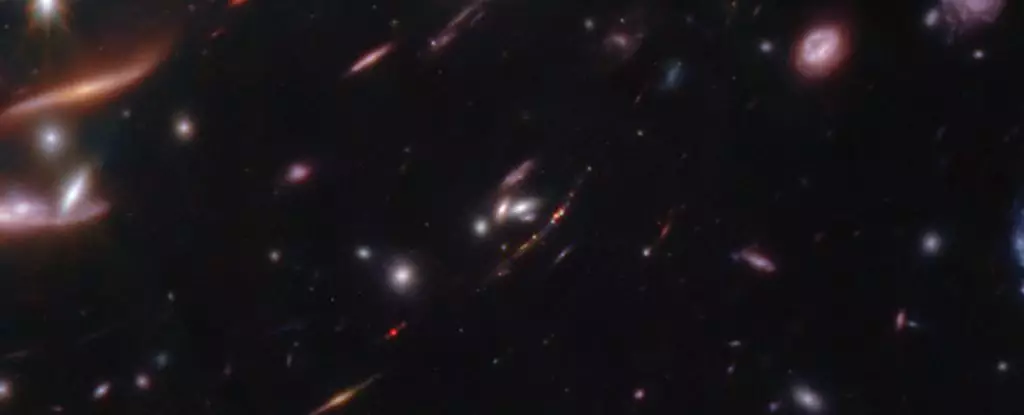The universe is an expansive tapestry woven from the remnants of stellar processes, and its origins remain one of the most captivating subjects of study in astrophysics. Recently, astronomers have caught a significant glimpse of what the early stages of our Milky Way Galaxy might have looked like through the observation of a distant galaxy named Firefly Sparkle. Formed a mere 600 million years post-Big Bang, this galaxy offers critical insights into star formation processes during a time known as the Cosmic Dawn, an epoch that laid the groundwork for the structures we see today. This observation marks a momentous advancement in our understanding of the universe’s infancy, achieved with the aid of exceptionally advanced technology and unique cosmic phenomena.
The remarkable ability to observe Firefly Sparkle can be attributed to the James Webb Space Telescope (JWST), the most powerful telescope to date. Its unparalleled infrared capabilities enable astronomers to analyze light that has traveled vast eons to reach us. A unique aspect of this observation is gravitational lensing—the warping of light caused by massive celestial bodies. These massive objects bend the fabric of space-time, serving as natural “magnifying glasses” that enhance our ability to view faint distant galaxies.
In the case of Firefly Sparkle, a massive foreground galaxy cluster acts as a lens, bending and amplifying the light emitted from this infant galaxy, which allows observers to see the breaking dawn of galactic evolution. The light arrives resembling ornate strands of sparkling fabric, with distinct clusters of stars forming within it. This striking view has enabled astronomers to not only resolve the structure of the galaxy into distinct clusters but also to trace its developing mass, likened to that of our own Milky Way in its formative years.
What makes Firefly Sparkle particularly intriguing is the complexity of its star formation. Lamiya Mowla, an astrophysicist from Wellesley College, expressed astonishment at the early resolution of such distinct star clusters within this galaxy. This discovery reveals an active environment with numerous phases of stellar birth occurring simultaneously. Various regions within Firefly Sparkle exhibit different colors and spectrums, indicating that stars at various stages of their life cycles are generating different types of light. The implications of these diverse stages further underscore how the galaxy is in an active state of construction.
Astrophysical research indicates that these star clusters constitute approximately half the galaxy’s total mass. Studying their formation not only sheds light on the processes that govern star birth but also provides essential clues regarding the formation of larger structures within the universe. Viewing galaxies in their infancy allows researchers to grasp the mechanisms of cosmic evolution in a way that more mature galaxies do not permit.
Interestingly, Firefly Sparkle is not alone in the void of space. Two neighboring galaxies lie relatively close to it, at distances of 6,500 and 42,000 light-years. This proximity suggests that these galaxies may be gravitationally intertwined, engaging in a cosmic dance of attraction that can lead to interactions and mergers. This phenomenon is a key part of galactic growth, a process that often leads to more massive galaxies forming through the absorption of smaller ones.
The Milky Way exemplifies this growth trajectory, having consumed several smaller galaxies over its lifespan. Yoshihisa Asada from Kyoto University posits that observing Firefly Sparkle and its companions may provide vital evidence supporting the theory that early galaxies formed through interactions and mergers. Each interaction represents a pivotal moment in the synthesis of our universe’s complex structures.
The insights gathered from Firefly Sparkle paint a profoundly vivid portrait of early galaxy evolution, offering an unprecedented window into the mechanics responsible for the universe’s formative years. Moreover, as astronomer Maruša Bradač of the University of Ljubljana suggests, this is merely the beginning. Numerous galaxies similar to Firefly Sparkle are expected to be uncovered by the JWST in the future. With advanced astronomical tools acting akin to microscopes, researchers can delve deeper into understanding the intricate components that lead to galactic assembly and the birth of stars.
As we continue to explore the cosmos, each revelation propels us closer to unlocking the mysteries of our origins, unraveling the complexities of cosmic evolution, and refining our perspective on the universe’s grandeur. The study of galaxies like Firefly Sparkle arms us not only with knowledge about their past but also with clues about our own Milky Way’s ongoing narrative—a story that has its roots firmly embedded in the harsh yet awe-inspiring cradle of the Cosmic Dawn.

